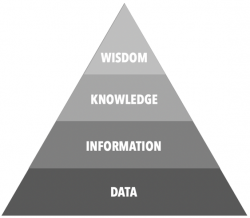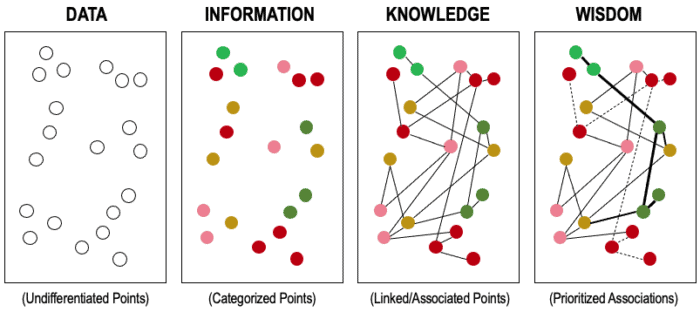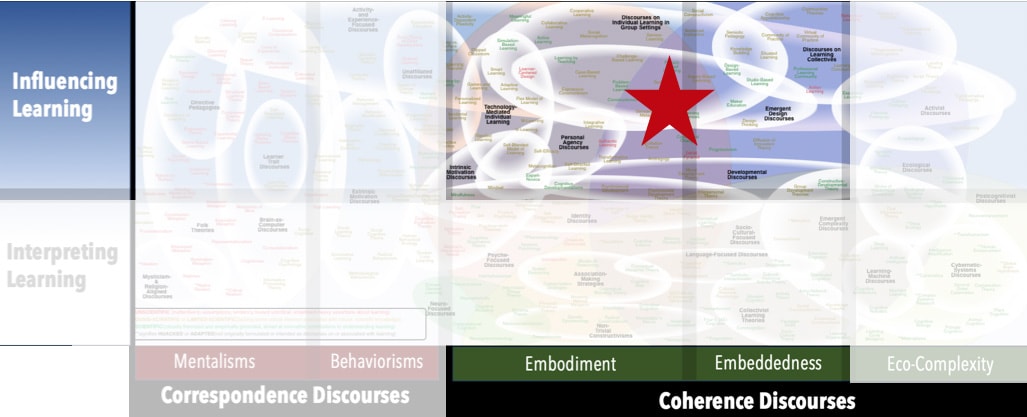AKA
Data Pyramid
DIKW Hierarchy
Information Hierarchy
Knowledge Hierarchy
Wisdom Hierarchy
Focus
Distinguishing among epistemological categoriesPrincipal Metaphors
- Knowledge is … information synthesized over time and across contexts
- Knowing is … meaning
- Learner is … information-using system
- Learning is … state-changing event
- Teaching is … varies, depending on focus
Originated
1990sSynopsis
The DIKW Pyramid is a catch-all description of several models explicating the relationships among ...- Data (Raw Data) – uninterpreted symbols,
 signals, unprocessed facts (e.g., counts, measurements, scores), unexamined images, unanalyzed recordings, etc.
signals, unprocessed facts (e.g., counts, measurements, scores), unexamined images, unanalyzed recordings, etc. - Information – data rendered useful through being organized, categorized, summarized, or otherwise structured
- Knowledge – know-how, based on information synthesized over time and across contexts (A much more nuanced appreciation of popular meanings of Knowledge might be gleaned by searching the term in the Comprehensive Index. See also a more detailed definition on the Key Terms page. As well, see Deep vs. Surface Learning for some popular subcategories of Knowledge.)
- Wisdom – know-why, grounded in situated understandings, historical perspectives, critical reflection, and other applied and connected knowledge (See also Wisdom (Sagacity; Sapience), under Well-Being Discourses.)
- Analytics Maturity (Gartner Analytic Ascendancy Model) (Gartner, Inc., 2010s) – a four-level framework that describes how Data are transformed into useful Information. The levels are: Descriptive Analytics (basic reporting); Diagnostic Analytics (analyses of root causes and correlations); Predictive Analytics (forecasting); Prescriptive Analytics (optimization).
- DIKUW Model (Russell Ackoff, 1980s) – a reconfiguring of the DIKW Pyramid with two major elaborations: (1) the incorporation of a time frame, in which Data, Information, and Knowledge are associated with the past and Wisdom with the future; and (2) the addition of “Understanding,” which is inserted between Knowledge and Wisdom and associated in the immediate present
- KID Model (Knowledge–Information–Data Model) (Ian Brodie, Lyn Brodie, 2000s) – an engineering-based model that foregrounds Information, which is located on a base of Data and which subsumes Knowledge as a special subtype (Wisdom is omitted.)
- Knowledge Spectrum (Anthony Debons, Ester Horne, Scott Cronenweth, 1980s) – a model that categorizes the progression of information processing, emphasizing the increasing complexity and utility of each stage in decision-making and learning. Two segments are distinguished: Data Driven Segment (i.e., the use of symbols and rules to transform events into Data); Cognitive Driven Segment (i.e., moving into Information, to Knowledge, and to Wisdom.
- STARS Knowledge Life Cycle (Han van Loon, 2000s) – a model of the transformation of Data into Information and then into Knowledge through a cycle of “Store, Transform, Analyze, Refine, and Share” – essentially capturing, organizing, analyzing, and sharing Knowledge within an organization or team, with each stage building upon the previous one to create valuable insights and learning
- Ladder of Inference (Chris Argyris, 1970s) – a model of the mental processes involved in moving from observable data to decisions and actions. The Ladder of Inference illustrates who quickly one can move from making observations to taking deliberate actions without recognizing subjective biases and situational filters. Its steps include:
- Observing Reality (Available Data) – the noticing of data and experiences, such as events, words, and behaviors
- Selecting Data (Selected Data) – the selection of specific pieces of data, as influenced by purpose, personal history, context, and culture
- Adding Meaning (Interpretations) – adding one’s own meaning, as influenced by beliefs and biases, both personal and cultural
- Making Assumptions (Assumptions) – making assumptions to fill in gaps of what one does not know directly
- Drawing Conclusions (Conclusions) – construing understandings of persons and situations
- Adopting Beliefs (Beliefs) – revising one’s system of beliefs about how the world works
- Taking Action (Actions) – acting on one’s beliefs, potentially creating a self-perpetuating feedback loop
- Knowledge Vee (Vee Heuristic) (Bob Gowin, 1970s) – a model intended to improve learning by making the connections between theory, research methods, and findings more explicit and accessible. The model connects aspects of conceptual/theoretical knowledge (on one side of the V) to elements of observations and practical methods (on the other side)
- Semiotic Ladder (Robert Stamper, 1970s) – a model intended to support understandings of how signs and symbols are interpreted in context, considering not only syntax and semantics but also physical manifestations along with the sociocultural dimensions. The Semiotic Ladder organizes meaning into different tiers and levels, typically including (from the simplest level to the most complex):
- Tier 1: Data (Morphological Level) – raw data with no interpretation or meaning
- Physical (Physical World; Physical Interoperability) – the physical signs that enable connectivity between networks
- Empirics (Empirical Interoperability) – the transmission of data through compatible channels
- Tier 2: Semiotics
- Syntactics (Syntactic Interoperability) – structured relationships among signs that enables transmission of data between systems
- Semantics (Semantic Interoperability) – interpretation of data in a manner that allows the sharing of meaning/information between systems
- Tier 3: Culture
- Pragmatics (Pragmatic Interoperability) – the adaptation of meaning to fit with situations, purposes, and/or audiences
- Social (Social Meaning; Social World; Social Interoperability) – collective interpretation of information in a manner that enables coherent interactivity (as evidenced, e.g., in shared beliefs, values, norms, etc.)
- Tier 1: Data (Morphological Level) – raw data with no interpretation or meaning
- Ethical Know-How (Francisco Varela, 1990s) – perspective on ethics as a way of being – an everyday living in the world – that’s rooted in an ongoing practice of self-transformation. This view breaks with a prevailing view of “ethics” as a formal, conscious, and/or rule-based system of judgment.
- Principled Practical Knowledge (Carl Bereiter, 2010s) – practical know-how that is informed by scientific insights
- Misinformation – inaccurate, unverified, or false Information that is unintentional. Types include:
- Error – honest mistakes in reporting or data interpretation (see Errors.)
- False Connection – headlines, images, or captions that don’t match the content but are shared without intent to deceive
- False Context – true information presented in a misleading way (e.g., an old photo used to misrepresent a current event)
- Satire (Parody) – content meant as humor but sometimes mistaken for truth
- Disinformation – inaccurate, unverified, or false Information that is intended to deceive and spread for malicious purposes. Types include:
- Fabricated Content – completely false information made up to deceive
- Imposter Content – fake sources or impersonating trusted entities
- Manipulated Content – genuine content altered (e.g. photoshopped or deepfaked) to mislead
- Propaganda – information designed to manipulate opinion, often politically motivated
Commentary
There are many, many variations of the concepts and distinctions addressed by the DIKW Pyramid. Differences in terminology, definition, and graphics reveal that imaginings of clear distinctions and logical hierarchies are obvious fictions – although, it would seem, not entirely un-useful, based on the resonance of the model with across so many audiences. To that end, recursive definitions of the levels out of Second-Order Cybernetics may render the model of greater use within education (e.g., Data = differences; Information = differences that make a difference; Knowledge = awareness of differences that make a difference; Wisdom = ethical action based on awareness of differences that make a difference). The following set of visual metaphors offers yet a different way to think about these categories: Additionally, several popular discourses foreground “wisdom” as a vital aspect of culture and a potential end of learning – including Constructive-Developmental Theory and many Well-Being Discourses.
Additionally, several popular discourses foreground “wisdom” as a vital aspect of culture and a potential end of learning – including Constructive-Developmental Theory and many Well-Being Discourses.
Authors and/or Prominent Influences
DiffuseStatus as a Theory of Learning
The DIKW Pyramid is not a theory of learning, but it can serve to orient attentions to key elements necessary in a theory of learning. For example, it is useful for separating out perspectives that address only acquisition of information.Status as a Theory of Teaching
The DIKW Pyramid is not a theory of teaching. However, it is a useful device for distinguishing among educational philosophies and the modes of teaching associated with those philosophies.Status as a Scientific Theory
The DIKW Pyramid is a catch-all that meets none of our criteria of a scientific theory.Subdiscourses:
- Analytics Maturity (Gartner Analytic Ascendancy Model)
- Data (Raw Data)
- DIKUW Model
- Disinformation
- Ethical Know-How
- Fabricated Content
- False Connection
- False Context
- Imposter Content
- Information
- KID Model (Knowledge–Information–Data Model)
- Knowledge
- Knowledge Spectrum
- Knowledge Vee (Vee Heuristic)
- Ladder of Inference
- Manipulated Content
- Misinformation
- Principled Practical Knowledge
- Propaganda
- Satire (Parody)
- Semiotic Ladder
- STARS Knowledge Life Cycle
- Wisdom (Sagacity; Sapience)
Map Location

Please cite this article as:
Davis, B., & Francis, K. (2025). “DIKW Pyramid” in Discourses on Learning in Education. https://learningdiscourses.com.
⇦ Back to Map
⇦ Back to List
